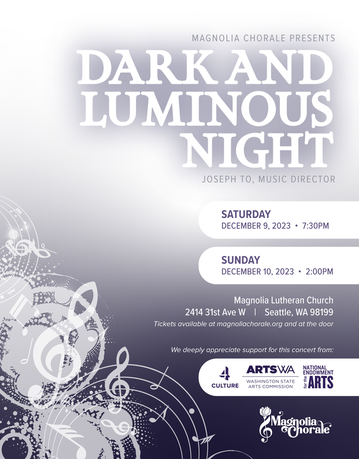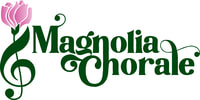
Program notes by Sabine Endrigkeit
Dark Night is an excerpt of a longer composition by the young Norwegian pianist and composer Ola Gjeilo, set to the poem Dark Night of the Soul by the Spanish mystic and monk St. John of the Cross. The poem likely was written in 1578 and "represents the hardships and difficulties met in detachment from the world".
Ola Gjeilo's choral works are often set to old sacred texts as they "deal with something that is bigger than ourselves". He hopes to write music that we can immerse ourselves in and "allows listeners to imagine their own stories in their minds as they listen to it." In his works the voices often create dense sound clusters which are often accompanied by rapid instrumental figures. Gjeilo, who is strongly inspired by Jazz-pianist Keith Garret, himself likes to improvise to his music on the piano.
The origins of O Magnum Mysterium, a medieval responsorial chant from the Matins of Christmas on Christmas Day, are not entirely clear. The text which describes the nativity scene with animals has captivated many musicians throughout history. The setting by Francis Poulenc is the first of four motets he composed between November 1951 and May 1952, entitled Quatre Motets pour le Temps de Noel. It is dark, tender and (by Poulenc’s standards) harmonically austere.
In Stiller Nacht is a song that entered the German folk song tradition a long time before it has been masterfully set for choir by Brahms. It is often thought to be a secular love song, harking back to the Minnesang poetic tradition in the way that nature responds to human suffering. Yet its origins might well have been of a sacred song about Christ’s suffering on the Mount of Olives (a similar song was first published in 1635). Brahms evaded questions as to where he found the song, yet he is known to have had deeply humanistic views and you will hear the secular version of the text in our performances.
Ich stand in dunklen Träumen. In addition to her early training as a pianist, Clara Schumann studied voice. Her love of Lieder—she published her first art song at age fifteen—helped cement the bond with her future husband. This mournful poem by Heinrich Heine was set by Clara Schuman as a Christmas gift to her husband. It delves into the depths of longing, reminiscence, and pain, painting a poignant picture of a person grappling with the absence of their beloved, yet the piano postlude ends on a peaceful note. Is this hope against all odds to see the beloved again, or are the sweet memories enough to sustain the lover?
O schöne Nacht In this poem the night has no more of the dread and turmoil previously heard. It gives rise to romantic feelings of beauty and love. Composed maybe in the summer of 1877 (published 1884) Johannes Brahms used extensive word painting to set this poem by Georg Friedrich Daumer (a poet very much preferred by Brahms), which is suffused with imagery of nature and love. The piano introduction with its upward moving arpeggios conjures up the moon with the accompanying stars, the nightingale's song is graphically illustrated by right hand trills while the harmonies become more mysterious when we learn about the lover secretly sneaking towards his beloved.
Bright morning star This beautiful choral arrangement by Shawn Kirchner of a traditional Appalachian spiritual starts out with the melody being sung by a baritone soloist—a very powerful entry that lifts us out of the darkness. The spiritual is likely dating from the 19th century. First collected/recorded by Alan and Elizabeth Lomax Kentucky in 1937, it has been sung by numerous folk artists, but was popularized in the folk revivals of the 1960s and 70s. The words to this song are typical of the shape-note hymn. The verse asking about the children with the response that they are dancing on the earth was added by Shawn Kirchner.
Ocho Kandelikas A Ladino Song for Chanukah was written by Flory Jagoda, who is known for her compositions and interpretations of Sephardic songs. She recorded the songs passed down to her by her Yugoslavian grandmother and later wrote songs for her own grandchildren. This joyful song of lighting eight candles for Chanukah has been arranged for choir by Joshua Jacobson.
Luminous Night is the second part of the excerpt of a longer composition Dark Night of the Soul by the young Norwegian pianist and composer Ola Gjeilo. After having gone through turmoil and suffering, the final stage is union with the object of love, the arrival in the light. "Here the self has been permanently established on a transcendental level and liberated for a new purpose".
Intermission
Gloria after having been forgotten for hundreds of years Antonio Vivaldi's Gloria RV 589 in D-Major (one of at least three Glorias that Vivaldi has written) is once again well-known and beloved today. As the autographs are lost, we can only assume the time of composition to be around 1715, falling into the time that Vivaldi was teaching at the Ospedale della pieta in Venice.
The Gloria RV 589 has many passages taken from Giovanni Maria Ruggieri's Gloria for double choir, yet Vivaldi's masterful composition, rather than being dictated by the text, follows the form of a concerto grosso. Vivaldi contrasts intimate solo arias with full chorale movements, the entire work being held together by the connective tissue of related musical motives.
Vivaldi starts and ends his Gloria in D-Major, which (in his time, well before the use of equal temperament became dominant) was the scale associated with triumph and rejoicing. Between these festive pillars Vivaldi musically intertwines Solo and Choir passages exploiting the full compositional palate of surprising harmonic twists, contrasts homorhythmical passages with lively and intricate rhythmic webs, sets delicate (joyful or mournful) solo arias between bold choir movements, and ends with a jubilant double-themed fugue. Let yourselves be uplifted!
